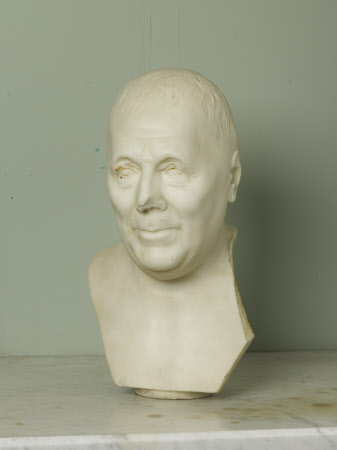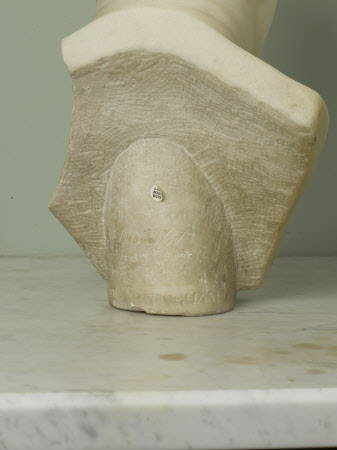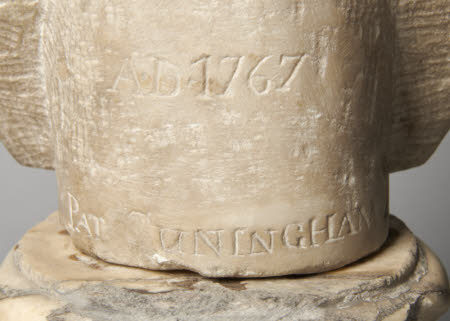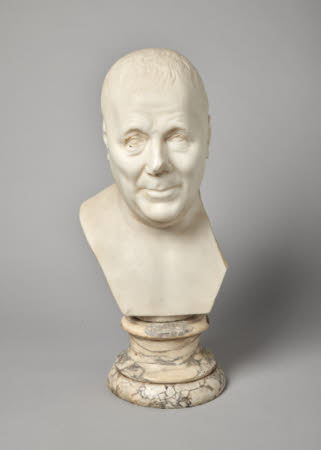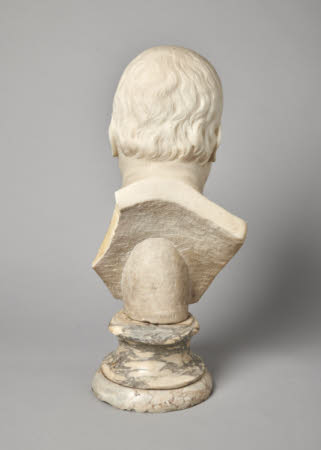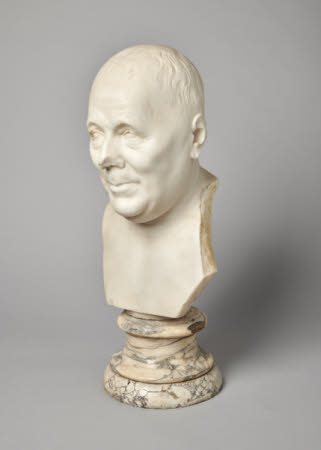Portrait bust of a gentleman, probably Alexander Stewart of Ballylawn and Mount Stewart (1700-1781)
Patrick Cunningham (d.1774)
Category
Art / Sculpture
Date
1767
Materials
Marble
Measurements
521 mm (H)273 mm (W)216 mm (D)
Place of origin
Dublin
Order this imageCollection
Mount Stewart, County Down
NT 1220124
Summary
Sculpture, marble; Portrait bust of a gentleman, probably Alexander Stewart of Ballylawn and Mount Stewart (1700-1781); Patrick Cunningham (d.1774); 1767. A portrait bust, by the Dublin sculptor Patrick Cunningham, of a mature man, probably Alexander Stewart, a successful linen merchant who bought the Mount Stewart estates and rebuilt the house.
Full description
A marble portrait bust of an elderly man, the bust section truncated. The man looks forward, with a quizzical expression. The ears are compressed against the sides of the head, indicating that the portrait is based on a lifemask or, less probably, a deathmask. Signed and dated on the back A.D. 1767 / PAT CUNINGHAM FT. [Pat Cunningham made this]. The bust is badly damaged, with the left shoulder lost and part of the nose broken off. Set on a veined marble socle. The making of life-or death masks has been practised by sculptors since ancient times, as a means of obtaining a close likeness of an individual, although it is an uncomfortable process for a living person. Casts taken directly from the front and sides of the subject’s head, usually with some gelatinous material, are used as moulds from which is cast a plaster model, on which the final marble would have been based. As the eyes of living individuals are necessarily shut tight during casting, these features have to be invented for the final sculpture, whether the subject is dead or living, whilst other features such as the mouth are often compressed during casting, so also need reworking in the final work. Sculptures made from deathmasks can sometimes be recognised, because the collapsing of the cheeks can still be seen in the final work, in a certain hollowness of the cheeks. In the case of the Mount Stewart bust, the lively expression and full face of the sitter would however suggest that he was living when the sculpture was made. The sculptor Patrick Cunningham lived and worked in Dublin until 1772, when he moved to London, but died there shortly thereafter, in 1774. Having trained with John Nost III, Cunningham set up his workshop in William Street, where he ran an extensive business, which included casting lead sculptures. His best-known work is his portrait of Jonathan Swift, now in St Patrick’s Cathedral in Dublin, which has been described as ‘much the best likeness of the Dean.’ Cunningham’s gift for portraiture can be seen in the bust at Mount Stewart. It seems likely to be one of the very last works in marble that he ever made, since in 1766 Cunningham sold all his models and moulds, and from around 1767 he worked exclusively as a modeller in wax. After his death, the Hibernian Journal (14-16 December 1774) commented that Cunningham ‘was a man of great fancy and imagination in architecture, statuary and waxwork, in the latter of which he excelled any in Europe.’ The subject of this excellent portrait is probably Alexander Stewart of Ballylawn and Mount Stewart (1700-1781), a successful linen merchant in Belfast and London, who purchased lands on Strangford Lough, rebuilding the house and renaming it Mount Stewart. Shortly before his death, Alexander Stewart also commissioned the Temple of the Winds from James Athenian Stuart. His son Robert (1739-1821), who completed the Temple after his father’s death, became the first Marquess of Londonderry. The marble portrait with its warm and lively expression may be compared with the painted portrait of Stewart at Mount Stewart, attributed to Andrea Soldi (NT 1221296) but, by showing the sitter without a wig, is notably more informal. Jeremy Warren May 2022
Provenance
On loan to the National Trust from Lady Mairi Bury (1921-2009) since 1976; accepted by HM Government in lieu of Inheritance Tax and allocated to the National Trust, 2013.
Makers and roles
Patrick Cunningham (d.1774), sculptor
References
Roscoe 2009: I. Roscoe, E. Hardy and M. G. Sullivan, A Biographical Dictionary of Sculptors in Britain 1660-1851, New Haven and Yale 2009, p. 330. Murphy 2014: Paula Murphy, ed., Art and Architecture of Ireland. III. Sculpture 1600-2000, Dublin/New Haven/London 2014, pp. 91-92.
